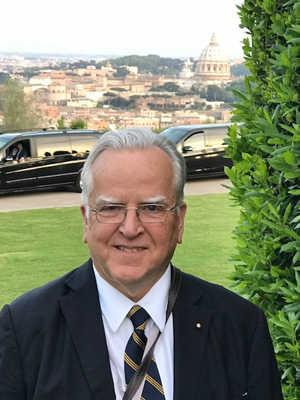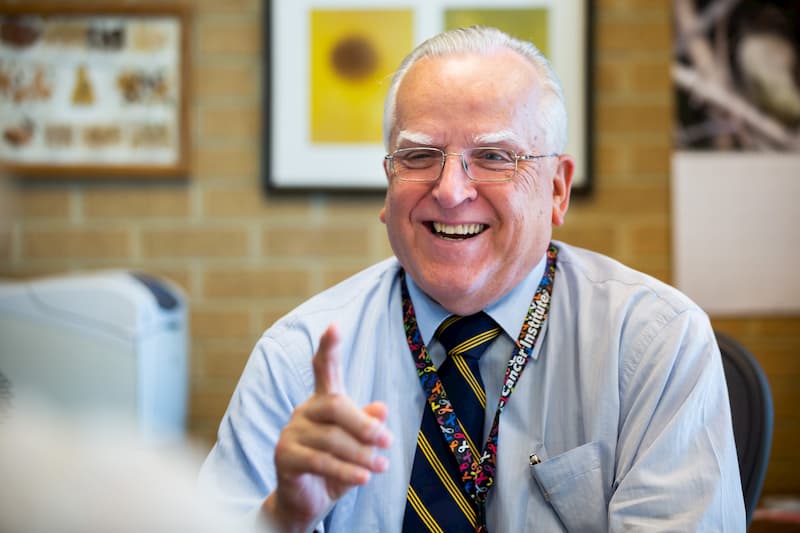CI leader participates in cancer discussion at Vatican

Dr. John Ruckdeschel, University of Mississippi Medical Center Cancer Institute director, was among about 300 people invited to the Fourth International Vatican Conference in April.
The conference, which takes place every other year in Rome, hosted medical entrepreneurs and academic, religious, media, advocacy and other leaders to explore “How Science, Technology and the 21st Century Medicine Will Impact Culture and Society.”
The conference is sponsored by the Vatican, the Cura Foundation, the STOQ Foundation and the Stem for Life Foundation.

Ruckdeschel answered questions about his experience.
Q: Why is this conference different?
A: In academia we often to go to meetings with academics and speak within our own world. When I go to the lung cancer meetings or academic oncology meetings, we talk about new technology but there won’t be entrepreneurs and people with start-up companies talking about where they’re taking the technology.
(The Vatican Conference) brings together a mix of academics and entrepreneur types from businesses, interdigitating them in the conversation and overlaying them with people from spiritual and religious persuasions and people who have a philosophical approach and people who are confronting the “wait a minute, if we do that, does it mean this or that down the line?”
These are groups of people who don’t usually get together. It’s not some guy who came in, gave a talk and left. We were locked in a conference center for three days. There was this cross fertilization that you usually don’t get.
They discuss consequences.
For example, with gene editing and gene therapy, sickle cell disease and sickle trait are likely to be one of the first diseases that can be eradicated. It turns out, if you have the sickle cell trait you don’t get malaria and if you’re in a malaria-infested part of the world, that’s important. In like manner, if you wanted to do away with malaria, you could go after the mosquito. All you’d have to do is mutate genes for reproductive capacity in a bunch of male mosquitos, you don’t have to get them all, and in a couple of years you don’t have mosquitos. But what else do mosquitos do in that environment?
Q: How can this conference help resolve tension that may develop between sectors?
A: If you go back to Galileo, Copernicus, Michelangelo, the (Catholic) church didn’t support science and how they perceived its intrusion on faith. One recent example was the kerfuffle on stem cells. The resolution was if you’re working with non-embryonic stem cells, derived from skin or fat or any other adult tissue, go ahead but when you cross over to using aborted fetuses to harvest stem cells, that is not a legitimate use of technology. At first it was, “No, no stem cell work could be done.” My sense is this conference came from the church’s desire to be part of the dialogue early on so these things could be considered as we went along. I don’t think we would have had that kerfuffle if people had recognized the impossibility of using aborted fetuses.
Other religious leaders who were there, Jewish faith and Latter Day Saints, offered interesting insights into what mattered and what didn’t matter. Unfortunately, they couldn’t gain collaboration from someone relatively high in the Muslim faith.

Q: What discussions stood out?
A: Regenerative medicine. Research is showing us that cells, not pills, may be the pharmacy of the future.
Research is underway to use stem cells in joint repair; rotator cuff diseases (instead of steroid injections); interstitial lung disease; bronchiectasis; to reduce lung rejection after transplant; cardiac and peripheral vascular disease; neurodegenerative disorders; multiple sclerosis; cerebral palsy; and autism.
But we don’t have any concerted research effort in regenerative medicine in the university. We do have people who can treat these disorders.
As a state, we have to make a decision: What areas are we going to invest in? One thing about being small and not having all the resources in the world is you have to make choices. To date we’ve not made a choice in this.
Gene therapy, too, offers hope for about 6,000 conditions with a molecular basis. About 500, mostly for children, have an existing therapy. The cost of sequencing human genomes has dropped and continues to drop. In several cases today, we can take a human gene, edit it, return it to your body and potentially cure your disease. These therapies are growing rapidly and bring much hope in cancer and other diseases. We have to watch for unintended consequences and use this knowledge ethically.
Q: What other talks impressed you?
A: One key scientific question was this idea that inflammation is at the root of all chronic diseases. It’s known that atherosclerosis is not just a disease of eating too much fat or too much cholesterol. There’s ongoing inflammation in the arteries. Lung cancer is related to the ongoing inflammation of pouring hot gases over pulmonary tissues. Autoimmune diseases are associated with chronic inflammation.
A researcher from the University of Alabama at Birmingham had fascinating maps that showed where the autoimmune diseases are in the country. Where are the biggest clusters of lupus, arthritis, etc.? In the Southeast, it’s a big black spot on the map and drifts off into little clusters. If you superimpose the maps for cancer, for heart disease, you see the same thing. But if you go to Denver and look up all the lupus patients, there’s no correlation with cancer or heart disease. That correlation only exists in the Southeast. Is that something in the environment? Is it genetic? Is it racially oriented?
I don’t think it is racial. When you go to other areas with large African American populations, you don’t see that. You would expect to see Detroit, Gary, Ind., or Los Angeles have those correlations, but you don’t.

Q: Did some speakers leave lasting impressions?
A: Yes. The Pope (Pope Francis I). The two telling things he said were number one, just because we can do something doesn’t mean we should do something. What if you could choose your kid’s hair color, or eye color, or height? Everybody in this forum pretty much considered that a negative. But it might not be a negative to folks who want kids with blonde hair, or a higher IQ.
The second piece was if we’re going to do it, it must be available in relatively short order to anyone who needs it, not just the wealthy
After the Pope, the most impressive was Francis Collins, director of the National Institutes of Health. He ran the Human Genome Project. He said, “I’ve been there. We determined the human genome. We know the complexity of it. We know it’s not just about measuring a bunch of nucleic acids and changing a few when something happens. There’s all sorts of complexity that goes into that.” He’s committed to his last cell to advancing the science and to making sure it’s done right.
Q: What’s your final take?
A: We need to consider whether we’re (Mississippi) going to be in the (research) background on this and as things become available, clinically, we’ll decide to do them or not.
Secondly, today we would have a very hard time making sure these types of studies are available across the board to poor people. It’s a bit of a struggle with our health care financing.
Finally, one thing from this conference and sitting there for three packed days is the extraordinary enthusiasm and the myriad opportunities that exist to make substantive changes in multiple diseases. With all the spinoffs that may go to the negative side, we’re still getting after disease we’ve never even been able to dream about treating like MS or sickle cell.


